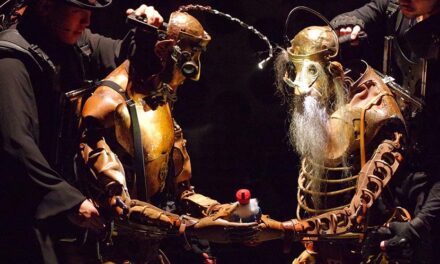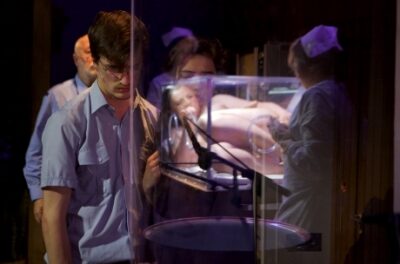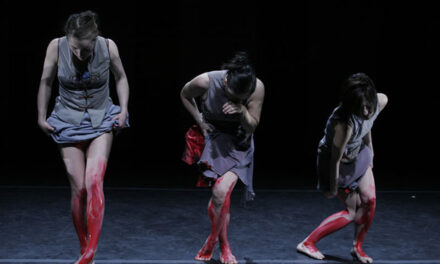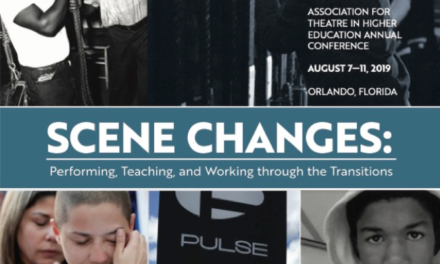On 21 June 2021, the Dramaturgs Network (a volunteer arts organization by and for dramaturgs working in the United Kingdom) held an online roundtable discussion to mark the launch of the d’n Dramaturgs’ Contract Package, a set of recommended practice documents designed to help dramaturgs and producers create fairer and better-informed employment contracts. The creation of this package was a six-year-long process that drew on the expertise of a wide range of employment and theatre professionals. At the heart of the work is a desire to enhance the visibility of the dramaturg’s work by identifying the many concrete tasks that the role embraces.
The panel comprised the three creators of the package: David Harris and Katalin Trencsényi from the Board of the Dramaturgs’ Network, Jarkko Lehmus, Finnish dramaturg and producer of Cirko – Centre for Contemporary Circus; they were joined by Ken Cerniglia from the Literary Managers and Dramaturgs of the Americas’ Compensation Task Force. The discussion was facilitated by Catriona Craig.
CATRIONA CRAIG: Please give us a background to the set of documents that you have created and describe how this project came about.
KATALIN TRENCSÉNYI: It started with a tweet, six years ago. I took advantage of an online open day at the Independent Theatre Council (ITC) where they encouraged people to ask questions via Twitter, and I asked a question that I felt has not been heard by the industry so far: “Isn’t it time that there should be an industry-wide acknowledged contract and minimum fees for dramaturgs?” The question was asked in the open and ITC had to respond in public. They said, “Yes, let’s meet.” That was six years ago. They kept their word, we had a meeting, and the first question I received there was “But what is a dramaturg? What does a dramaturg do?” So the first thing I learned from these conversations was that beyond those people who do dramaturgy, the wider industry is unaware of the work of dramaturgs. For instance, initially, we were offered a writer’s contract. They said, “Okay, tweak this a bit and then we’ll end up with something for dramaturgs.” It took many conversations for the ITC to understand that a playwright’s contract is different from a dramaturg’s contract because our work is very different. A dramaturg’s work is complex, it’s relational work, it’s a collaborative role: we work in dialogue with artists and organisations. Most of the time dramaturgs are invited to participate in high-risk projects where they bring their expertise to help resolve complex issues.
Furthermore, the area where dramaturgs operate is vast. We can talk about new drama development, research and development (R&D), staging classics, opera dramaturgy, dramaturgy for musicals, devised work, ballet, contemporary dance etc. And the tasks will be very different.
It can further complicate things that a dramaturg can fulfill different roles. They can function as an expert, a consultant or the dramaturg can work as a creative contributor, for instance, they can be a collaborator in devised work. Not to mention that, especially in contemporary performance, sometimes it’s the concept that matters. Dramaturgs can come up with concepts or contribute ideas that can be beneficial to a performance.
This all boils down to one issue: challenging the myth of a single artist-genius creator of the work. Theatre-making is a collaborative process, therefore dramaturgy is a collaborative process. And with these documents we developed, we wanted to make the dramaturg’s invisible work visible.
The second thing I learned during this process was that we have to have dramaturgs around the table where people are negotiating dramaturgs’ contracts and fees, who can understand and explain this very complex way of working. That’s why the package is a result of teamwork. Our Working Group comprised a producer (Jarkko), a legal-managerial expert (David) and a dramaturg (myself). We needed the knowledge and expertise from all of these areas in order to negotiate between our different viewpoints, and develop a package that is useful for dramaturgs as well as managers and organizations who want to engage them, but is also realistic about the UK theatre ecology and economy. For this reason, we organized several meetings with representatives of other guilds, unions and professional bodies (such as Equity, the ITC, Stage Directors UK, The Society of Authors, and the Writers Guild of Great Britain) to share and discuss with them our various drafts and include their suggestions in them. Sadly, the d’n is too small an organization to have negotiating power, therefore the resulting package is only a recommendation by the d’n and not an agreement between these organizations, but I believe it is an important first step.
CC: How might this package support people working as freelance dramaturgs?
DAVID HARRIS: I’m going to start by talking about the situation forty years ago when personnel management in Britain became ‘human resource management’, which saw employees as literally a resource that could be used and managed strategically, tactically, and operationally. Personnel management used to cover record-keeping on employees, welfare, pastoral care and training and operationally. They were considered to be kind and caring, whereas HR managers lived up to their name and became known for being lean and mean. Organizations in both the public and private sector began to think differently about how they used their staff, their employees. Jobs became ‘roles’. Work was not about what you did but really who you were.
Freelance work, ever-present in theatre-making, blossomed in many other sectors. Being freelance became synonymous with being self-employed which has now become known as the ‘gig economy’. The rise of the gig economy in the wider world has meant freelance workers have had to live with poor terms and conditions. Only in recent years has there been any challenges or fight back which required legal action. We are all aware in the UK, that self-employed plumbers and taxi drivers engaged by Pimlico Plumbers and Uber have made great headway in securing rights and benefits after a struggle through the courts.
Given freelance working will remain the norm in the theatre industry we need contracts that deliver terms and conditions of engagement which reflect the nature of the work and compensate fairly.
CC: Where are today’s freelancers in theatre-making in all this? Where does our industry sit?
DH: I doubt that freelance theatre-makers have the muscle for a similar battle. Yet, we all are aware of the precarity of their situation. The nature of production work is temporary and often short, it’s a high risk both in financial and creative terms, and of course, the supply of labor greatly exceeds demand. This landscape has enabled producers and managers to hire creative freelancers very cheaply to keep costs down and reduce risks. It suits producers, it suits venues, and most importantly it can suit directors, designers and other creatives such as dramaturgs who want to try a range of work in their early careers. So despite Equity, the ITC with its Ethical Managers’ Agreement, and smaller supportive organizations, for freelancers there is no still no guarantee of sick pay, holiday pay, insurance, and pension.
The situation gets worse. The austerity drive in the UK ten years ago reduced levels of subsidy, and a dog-eat-dog situation developed with ‘secondary’ theatre-making creatives placed lower down the food chain. Directors are asked: “How cheaply can you get x or y as a designer?” Good working relationships between directors and other creatives are often exploited with the sole aim of reducing costs. As we all know, the best-established creatives have agents who can fight for them but the majority rely on a network of fellow professionals for help and guidance, which is where the Dramaturgs’ Network comes in.
We need contracts that deliver terms and conditions of engagement, reflect the work and compensate fairly. Furthermore, and as Katalin mentioned, the nature of a dramaturg’s work means it’s invisible. The contribution of dramaturgs is often not recognised. For example, there are agreed terms and conditions for directors with Equity, and the Independent Theatre Council has contracts for directors and designers. There is no agreed, accepted or recognised contract for dramaturgs, that’s why we have decided to produce our own. It has not been agreed or recommended by any employing organisation, but it will be available as a model for dramaturgs and ethical producers to tailor to the specific needs of their company or their production.
The pandemic has created a watershed in our industry; freelance theatre-makers are in a far poorer position when they are agitating for a better deal: pension, holiday pay, sick pay and more. Our Dramaturg’s Contract Package could not be launched at a more suitable time.
CC: Ken, could you reflect on this context from the position of the Literary Managers and Dramaturgs of the Americas?
KEN CERNIGLIA: At LMDA about twenty years ago we started a similar process, at least sketching out some employment guidelines. When I joined the organization in the late ‘90s, there was a vote of the membership on whether we wanted to unionize. A prominent case highlighting the invisibility of dramaturg’s work and lack of equitable compensation pushed the issue into the foreground. The membership decided not to unionize mostly because of the vast diversity of the work of the dramaturg within the organization and across institutions (and countries). How could we hammer that all into the conformity required of a union?! And so we decided to remain a guild, which doesn’t have as much power as a union, but we would work on some employment guidelines and recommendations for engaging negotiations, even if we were going to put ourselves in a position where we couldn’t collectively bargain.
This is quite different from almost all of our professional counterparts in theatre-making, in the United States at least. We’re in a similar boat to the Dramatists Guild of America, which is not a union because each dramatist in the US is considered an individual business that licenses intellectual property for production. A union of dramatists could then be considered forming a trust, which is against antitrust laws in the United States. (This may be changing with some proposed legislation.) Dramaturgs are caught somewhere in the middle, because some of our work is labor, particularly around production dramaturgy, and our new-work dramaturgy contributes directly to the dramatist’s intellectual property.
KT: It’s quite incredible that creatives are prevented from protecting their rights by joining forces!
KC: On some levels, yes, it doesn’t make sense. The history of contract negotiations in the industry over the last century has led to some bizarre results! So anyway, twenty years ago LMDA started to work on these employment guidelines, and out of that came some sample contracts, some templates for various positions, whether that’s a festival we are working on, for an institution, freelance work, etc. We’ve been using that for the last ten years. And we are revising it again because things change and we need to keep abreast, particularly freelancers. In the United States, you may know, we have no national health service, and so often health care coverage is tied to full-time employment, which is particularly difficult for anyone who is working freelance.
So we have to do two things: advocate for dramaturgs within the theatre industry, where most of us work (although many work in dance, opera, film and television, among other industries), and advocate for artists within the general labor market.
We have had international collaboration in our advocacy work very much since the beginning of this process, since about a fifth of the LMDA membership is Canadian. And we have extended beyond that with the recent formation of LMDA Mexico, which is just now addressing these questions within their particular artistic and labor ecosystem. All of these individual efforts ultimately inform and bolster the others, which is one of the reasons I’m so glad we are engaged in this conversation with Dramaturgs’ Network, whose contract package is situated differently from what we are doing. It’s a bit more intermediary, and a little bit more assertive, which I hope to incorporate into our work on the other side of the Atlantic.
CC: What’s LMDA focused on at the moment?
KC: We are currently making some headway collaborating with general managers, who are essentially the business hub of commercial theatre, to get them to understand our work as dramaturgs but also collaborate with us in solving labor and compensation challenges holistically. And so we’re looking at the other theatrical contracts: designers, directors, dramatists, etc. General managers need to see templates, and our template should resemble those of the other unions and guilds, to compare apples to apples when appropriate. We are also focused on not only compensating for the labor when they see the dramaturg in the room but also looking at the dramaturg’s time overall – all the work outside of the room. We dramaturgs are quite bad at keeping track of our own hours, and we low-ball ourselves a lot in a negotiation, like, “Oh, I can do that for this fee.” But did we break that task list down by all the hours it will take to complete?! No, we did not! Dramaturgical thinking and labor always fill the time available, and often extend beyond that, so we must set parameters and hold ourselves accountable to them. So, we need to break down our work into hours and be clear about the tasks on offer to those who hire us. Do you want us to do this? Do you want us to do that? And then we can outline deliverables associated with those yeses.
Beyond the labor and dramaturgical deliverables to the production is that we are often there at the idea stage, as Katalin said early on. What’s the value of our ideas? What kind of creative contribution are we making to the work that ultimately will be owned by the dramatists, by the director, by the producer? So let’s make sure when we enter into these negotiations that we are talking about not only our time and our labour but also our creative contribution to the work and how that will be compensated.
The bottom line is how do we – clearly and consistently – advocate for our labor and contribution to the ultimate work of art? If we do our jobs well, that work will be invisible to the audience. And that’s our quintessential challenge.
CC: Ken, you raised some really interesting points about seeing the world from the point of view of the people whose job it is to hire dramaturgs. So, Jarkko, I wonder if you could speak from the point of view of the producers and also comment on how things look to you from your experience in Finland?
JARKKO LEHMUS: Although I too work as a freelance dramaturg, in this discussion about the contractual package, I’ll employ the perspective of a producer: How is this contractual package usable for me? Is it easy and quick to use? And what does it do?
Strategic thinking is really important for the resilience of an organization. However, I believe that the vision of an organization shouldn’t be only about visualizing the future of the organization but visualizing the world the organization wants to build by its actions. And David very clearly outlined the neoliberal gig economy, where under the disguise of freedom lurks precarity, and where responsibilities are shifted from the organization to the individual.
Profit and efficiency-orientated managerialism are really very much at odds with the idea of caring. And I’m bringing the notion of caring in here because as a producer and a dramaturg responsible for the performance program for an organization, I do flirt with the term ‘curating’, which stems from the Latin word cūra, meaning ‘care’. In this sense, a curator is a person who has the responsibility of taking care of something. In the museum and visual arts context, this caring mostly means taking care of the art objects, but quite often, not the art workers. And this is quite well documented. But in the performing arts context, the performance is the art object. So, all of the art workers are essential to make the performance happen. From this perspective, taking care of the art workers is also curating in the context of performing arts.
CC: How does this translate into your practice as a producer or manager?
JL: As a responsible manager, I should recognize and take the responsibility of an employer. From my perspective, this is quite simple. There are certain responsibilities that need to be taken. Do I take them, or do I push them to the worker?
An organization has the infrastructure for taking care of people, so we really should do that. But taking responsibility for the social costs, the health of the worker costs money. So I really need to write the responsibility that I take into the budget. And in order to be able to do this, a manager needs to understand the work itself. When we are looking at a dramaturg’s contract, the question is what does a dramaturg do? What do they need to do what they do? In the context of creating a performance, which roles should I relate a dramaturg to? Who is a dramaturg on a level with? Are they on the level with a designer or director? Where are they in the production?
And this is where the task list of the d’n Dramaturgs Contract Package comes into play. It is a very clear set of tasks to look at. I need to write a job description into the contracts, and that’s exactly what the task list helps me to do. And through that I can understand how much time the tasks take, how much money I need to reserve in the budget for the working time of the dramaturg.
In Finland dramaturgs are unionized, we are part of The Union of Theatre Directors and Dramaturgs. Our small sub-union is part of the larger union of theatre and media workers, which have these small satellite unions for lighting and sound designers, costume and scenographic designers, choreographers, dancers, and circus artists and so on.
We have a system of collectively negotiated terms and conditions of employment. And in the Terms and Conditions, the dramaturgs’ intellectual property rights are recognized on a level with the designers’ intellectual property. But the perspective of what a dramaturg does in the T&Cs is very much from the perspective of large, institutional, publicly-funded theatres that have a full-time staff. So a dramaturg’s definition in Finland is often reduced to defining it as a literary manager only. Although performance dramaturgy is mentioned in the T&C, but not really outlined as to what it is. Therefore there’s still plenty of work to be done, but at least we are recognized, and our intellectual property is recognized as well.
CC: You’ve mentioned the value of the task list, this attempt to capture the definition of the various things that a dramaturg might do. Katalin, could you give an overview of the documents in a little more detail?
KT: The package contains a manual that explains how to use the contract. It comprises guidelines for engagement, and it explains, step by step, the contract clauses. And it is created in a way that it can be tailor-made for each situation. There are three appendices with detailed job descriptions for new drama development, production dramaturgy or collaborative processes, and they distinguish between three levels of the service: basic, standard and specialist’s services.
We have also pledged to update this package in February 2022, so we welcome feedback from users, ideas of what can be further improved.
CC: Finally, I’d like to get your thoughts on what we can all do to help ourselves articulate what we do more clearly.
KC: In the United States, our educational system is seriously lacking in business training for artists. We have an unfortunate polarisation of ‘creative types’ and the ‘money types’, which puts artists at a disadvantage in contract negotiations. So, we have to educate ourselves.
We need to spend time with these documents. The d’n Dramaturgs’ Contract Package is comprehensive (there’s a lot of stuff in there!), but once we are able to digest it, to understand the underlying principles, the better prepared we’ll be to advocate productively for ourselves within context. We have to develop a sense of collaboration at the negotiation table, not just in the rehearsal room. In addition to an outline of the scope of work and compensation for that work, a contract is a moral document, a representation of values, and an obligation to manifest them.
One drawback of Western thinking is our assumption of dichotomy. If there are two people in a negotiation, then the relationship must be adversarial. It’s you versus me, and we have to battle it out to come to a common ground. Be we, as dramaturgs, often think much broader than that in our artistic practice. So let’s bring that approach to this table. If I can come into my negotiation knowing very well what I can do, including my limitations, and understanding my counterpart’s position and objectives, I can have a leg up in the long game. Am I willing to put this particular job on the line to educate and advocate for the profession? Can I say: “Are you interviewing enough people? What exactly do you need here? Because one size does not fit all when it comes to dramaturgy. How are you building your team? You know, it’s possible that my experience, my knowledge base isn’t the best fit.” That’s a hard thing because we all want a job, but entering into this collectively, not just within our own situations, our own countries, but globally, we will be in a better position to negotiate. This approach can be disarming for the ‘other side’. From a producer’s perspective it would mean that it is no longer one more individual artist crying for their share of our limited-resource pie, but rather “Here’s someone who actually understands my job, and I have an ally on the other side of this negotiation table. Let’s create something productive together.” It’s about building trust, just as we do with our artistic collaborators. We can speak Art and Business. We understand text and context. Let’s use that in our advocacy work.
Getting very familiar with the nuts and bolts of a contract – just as we do the text of a play – makes us an ally in the room with a producer or representative negotiating with us. Maybe we can help them figure out something else that they are working on. That’s what dramaturgs do: understand structures and solve problems.
KT: With this, we have come full circle, we arrived at macro dramaturgy: bringing our awareness beyond the artwork and thinking about the working process. Let’s think dramaturgically about contractual processes too! Agreeing with Jarkko and Ken: an organization’s curatorial thinking should include thinking about taking care of the work, taking care of the process, the community, and the moral obligations of taking care of the artists. That’s macro dramaturgy. So let’s continue to engage in that conversation.
This roundtable, Towards Fairer Contractual Practices, was organized by the Dramaturgs’ Network and it took place on Zoom on 21 June 2021. The conversation was transcribed by Roland Kelemen and edited by Catriona Craig.
To access the contracts package please visit the Dramaturgs’ Network’s website.
If you would like to offer feedback or pursue the conversation about employment conditions further, please email to contract@dramaturgy.co.uk

Catriona Craig
Catriona Craig has worked in dramaturgy and script development for stage and screen for over fifteen years, most recently on Close Quarters for Out of Joint. She also produced their young writer development programme, The Andrea Project. She is senior lecturer in Performing Arts and Acting at Buckinghamshire New University. Catriona is also a freelance script editor for TV and film in the Republic of Ireland.

Ken Cerniglia
Ken Cerniglia is a veteran dramaturg, writer, creative consultant and organizational leader. His dramaturgy includes the Broadway hits Hadestown and Peter and the Starcatcher and over 70 other titles during his 16 years at Disney Theatrical. He is a past president of LMDA and holds a PhD from the University of Washington.

David Harris
David Harris worked as a stage manager and company manager before qualifying as a Company Secretary and as an MBA. He was Business Manager at Company of Angels for nine years and worked on two major European festivals. He was also Finance Manager of Told by an Idiot and is now Business Manager for Simon Spencer Productions Ltd.

Jarkko Lehmus works as a producer and dramaturg responsible for the artistic program of Cirko – Center for New Circus in Helsinki, Finland. As a freelance dramaturg, director and choreographer he specializes in non-verbal performative arts.

Katalin Trencsényi is a dramaturg, researcher and theatre-maker working and teaching internationally. She is the author of Dramaturgy in the Making. A User’s Guide for Theatre Practitioners (Bloomsbury Methuen Drama, 2015). Katalin is co-founder of the Dramaturgs’ Network.
This post was written by the author in their personal capacity.The opinions expressed in this article are the author’s own and do not reflect the view of The Theatre Times, their staff or collaborators.
This post was written by Catriona Craig, David Harris, Ken Cerniglia, Jarkko Lehmus and Katalin Trencsényi.
The views expressed here belong to the author and do not necessarily reflect our views and opinions.


















